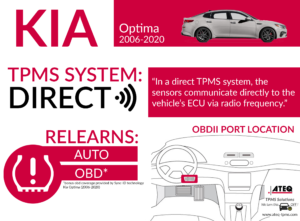Back to the news page
03.01.2020
TPMS Diagnostic Information – Kia Optima, 2006-2020

Over the next couple of months, we will be reviewing the best-selling Cars, SUVs, Minivans, and Trucks of 2019. During the month of March, we will focus on the best-selling cars in 2019 in the United States.

After the TREAD Act was mandated in 2007, all vehicles manufactured in the United States beginning in 2008, must be installed with direct or indirect TPMS systems.
The Kia Optima uses a direct TPMS system, which means TPMS sensors are installed in the wheel. If one or more tires indicate low tire pressure, the TPMS sensors will transfer the information to the vehicle’s ECU. An indicator light (low-line TPMS system) or each tire pressure will show on the dash (high-line TPMS system).
When a tire is inflated, rotated or changed in one or more tires of a Kia Optima, a TPMS relearn must be performed to write the IDs to the vehicle.

If your Kia Optima is equipped with a high-line TPMS system, the actual tire pressure is displayed on the dashboard. However, according to the Kia Optima’s owner’s manual, the numbers displayed on the high-line system may differ from the numbers retrieved if using a tire pressure gauge.
The TPMS malfunction indicator may be illuminated if snow chains are used or some separate electronic devices such as notebook computer, mobile charger, remote starter or navigation etc., are used in the vehicle. This can interfere with the normal operation of the Tire Pressure Monitoring System.
Relearn procedures differ from manufacturer to manuf...
Learn how to service different models on the Hyundai...
During the month of March, we will focus on the best...